1845 First Mechanical Chirographer Invented
Charles Thurber, a Norwich resident from 1842-1847, was an inventor, and could be considered a Renaissance Man. During his lifetime he: a) Was a Latin school teacher, and b) the principal of a Latin Grammar school, and, c) invented four different typewriter models, and, d) Along with his partner, Ethan Allen, established and operated the Allen & Thurber firearms manufacturing facility in Norwich.
In 1845, while in Norwich, Thurber patented the “Mechanical Chirographer”, (a.k.a. Calligraph). The Chirographer, (shown on the left) was essentially a mechanical handwriting machine; notice the pen shaped stylus near the center of the photo. It was intended to be a tool that blind people could use to correspond with others.
However, in 1845, typewriters and writing machines were not popular with the general public. In his book, “Antique Typewriters”, Michael Adler discussed this sentiment :
”The conventional wisdom was that letters were intended to be written by hand – that personal touch was considered vital. Beautiful script was what counted, not some new-fangled machine-made text.”
*Place cursor over image to magnify
The machine was not well received by the public, and, did not do well in the market place. However, Charles Thurber did not give up. After he moved to Brooklyn, in 1857 and then again in 1860, he patented improved models of the 1845 Mechanical Chirographer.
Acknowledgements
OzTypewriter.BlogSpot.com
“Antique Typewriters (From Creed to Qwerty),” 1997, by Michael Adler
The complete list of sources may be found by clicking the “Bibliography” button, and, then typing “Chirographer” in the SEARCH box.
1846 First Bomb-Lance Harpoon Invented
Oliver Allen, of Norwich, Connecticut, was the inventor of a bomb-lance (1846), an improved gun-harpoon (1848), and an improved bomb-lance (1863). Hand-held shoulder whaling guns, like the one shown below, were used to shoot both bomb-lances and harpoons designed by Oliver Allen. All of his inventions were used by whalers in hand-held. shoulder whaling guns.

This is an example of a “Brand No. 1 Hand Held Shoulder Gun”, made by Christopher C. Brand, (Oliver Allen’s associate). Either lances or harpoons could be fired from this same gun.
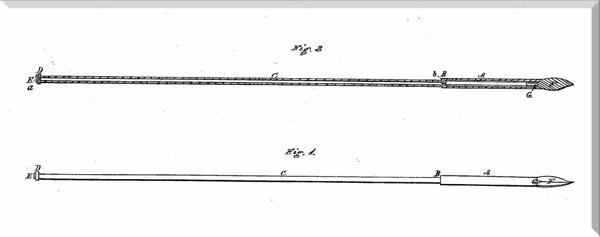
This drawing of a bomb-lance is a component of Oliver Allen's 1846 patent. The patent states : "Be it known that I, Oliver Allen, of Norwich, in the county of New London and the State of Connecticut, have invented a new and useful Projectile for Killing Whales or other Fish, or for other purposes to which it may be applicable, the same being termed by me a "bomb-lance ..."
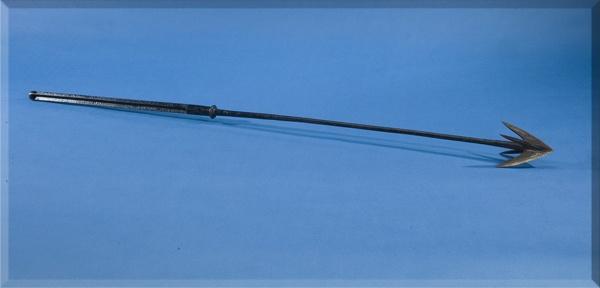
This is a photo of the "Improved Gun-Harpoon" built in accordance with Oliver Allen's 1848 patent. An excerpt from the patent states :
"The method heretofore used for attaching a line to a gun-harpoon has been to secure it to a swivel made to freely slide upon the shank. The said swivel, as soon as the instrument leaves the gun, falls back against a button or head made upon the rear end of the harpoon ..."
According to Info Source : ”The earliest American whaling shoulder gun that we know of was made about 1847 by Oliver Allen of Norwich, Connecticut. His associate was Christopher C. Brand, who slightly modified Allen’s design. Allen took off for the California gold fields in 1849 and eventually settled in Petaluma, where he was known as an ingenious inventor.”
After Oliver Allen sold his business in 1849 to Christopher C. Brand and his company, the C. C. Brand Company., continued make whaling guns that used Allen’s designs.
Acknowledgements
“Whaling Tools in the Nantucket Whaling Museum,” p 16, (1998), by Robert E. Hellman
Australian National Maritime Museum
National Museum of American History
The complete list of sources may be found by clicking the “Bibliography” button, and, then typing “bomb-lance” in the SEARCH box.
1854 First Lever Action Gun Invented
“The dream became a reality when Horace Smith and Daniel B. Wesson formed their first partnership in 1852 to manufacture a lever-action pistol that incorporated a tubular magazine which fired a fully self-contained cartridge. This new repeating pistol could be fired as rapidly as the lever, which loaded the pistol and cocked the hammer, could be manipulated. The firepower of this lever-action pistol was so impressive that in 1854 when the gun was reviewed by Scientific American, it was nicknamed the Volcanic because its rapid-fire sequence had the force of an erupting volcano.” (Info Source 1)
During the 1852-1854 period Horace Smith and Daniel B. Wesson designed and developed magazine firearms and cartridges. In 1854 they founded, along with Cortlandt Palmer, the Smith & Wesson Company in Norwich. This company completed the development of the first repeating gun.
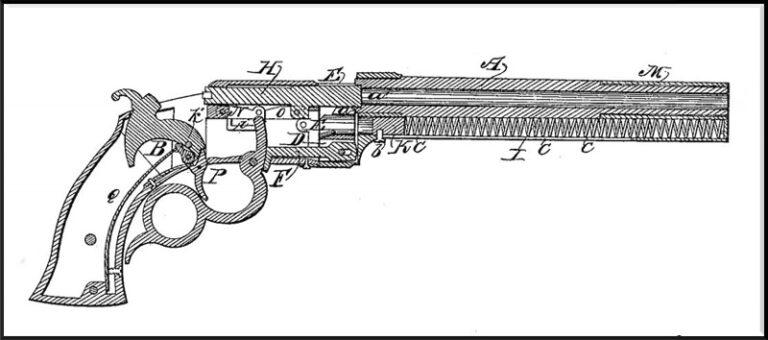
The image shown above is a copy of a drawing that is included in the Horace Smith and Daniel B. Wesson 1854 patent for an “Improved Firearm”, (Patent No. 10,535).
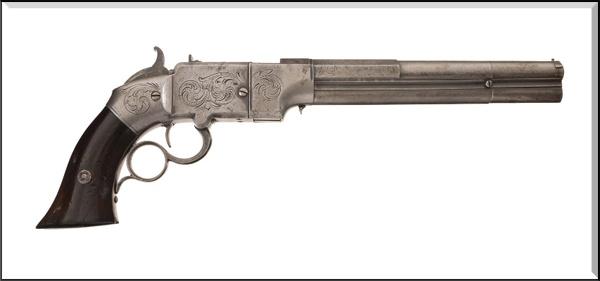
The gun shown above is a rare example of the 8 inch long, 41 caliber, lever action magazine pistol.The gun was the first lever action type firearm and it fired metallic rim fire cartridges. It was produced by the Volcanic Repeating Arms Company, in accordance with Smith & Wesson’s 1854 lever-action patent.
The Smith & Wesson Co. of 1854-1855 turned out to primarily be a design, development and proof-of-concept operation. By the end of 1854 the company was in financial trouble. The Smith & Wesson Company and all the production rights were sold to Oliver Winchester; at that time a shirt manufacturer. He renamed the company to the Volcanic Repeating Arms Company in 1855. Winchester later found great success producing repeating rifles.
Acknowledgements
“Improvement in Fire-Arms, Patent No. 10,535,” 1854, by Horace Smith and Daniel B. Wesson
Rock Island Auction
The complete list of sources may be found by clicking the “Bibliography” button, and, then typing “lever action” in the SEARCH box.
1854 First .22 Caliber Cartridge Bullet Invented
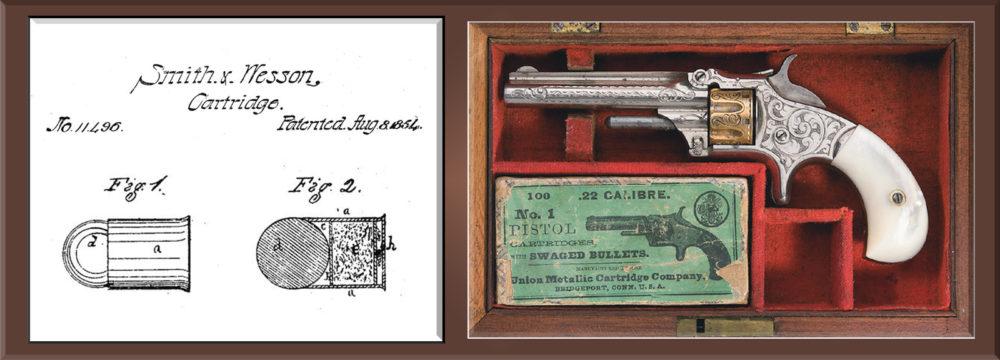
While in Norwich, in the 1854 S&W patented (Patent No. 11,496 shown in the photo on the left) a new style of cartridge that is the forerunner of all rim fire cartridges today. This rim fire cartridge consisted of a .22 caliber casing, primer, gunpowder, and a bullet. They called it the Number One Cartridge.
The cartridge was not used in any guns produced by the Smith & Wesson Co. of 1854, however, it became the basis of the Smith & Wesson Model Number One revolver. The Model One (shown above in the photo on the right) was introduced in 1857 and was manufactured in various forms through 1881. This style of gun marked the beginning of the modern era of self-contained cartridges and the beginning of a profitable Smith & Wesson.
Acknowledgements
Norwich Arms Gazette, 2003, Vol. 1 Issue 4
“Images of America – Smith & Wesson,” 2006, by Roy G. Jinks and Sandra C. Krien
“Improvement in Fire-Arms, Patent No. 10,535,” 1854, by Horace Smith and Daniel B. Wesson
Rock Island Auction
The complete list of sources may be found by clicking the “Bibliography” button, and, then typing “22 caliber” in the SEARCH box.
1857-1859 Window Blind Staple Patents
Norwich’s Byron Boardman was a very important employee of the C.B. Rogers manufacturing company due to the seven patents that he was granted from 1855-1868. One of his contributions was machine that made staples for window blinds. The photo on the right is an 1859 adverstisement intended to attract prospective buyers of both his window blind staple machine and his patented window blind staples.
In his words, printed in the patent application for the staples he states: “The nature of my invention consists in constructing the wire staples for connecting the slats of window blinds, and screens, with indentations on the part which is to be driven into the wood, and tapering and pointing the penetrating branches of the staples in order that they may be applied or driven more readily without previous boring in the wood, and that they may sustain greater force without being drawn out.”
Machine for Wiring Blind Rods ~ Patent No. 18,080 ~ 09/01/1857
Staple for Blind Slats ~ Patent No. 19,747 ~ 03/30/1858
Acknowledgements
“Stedman’s Directory of the City and Town of Norwich, 1881,” p 295
Machine for Wiring Blind Rods, Scientific American, 11/05/1859, p 304
Machine for Wiring Blind-Rods, 1857, U.S. Patent 18,080
Staple for Blind-Slats, 1858, US Patent 19747